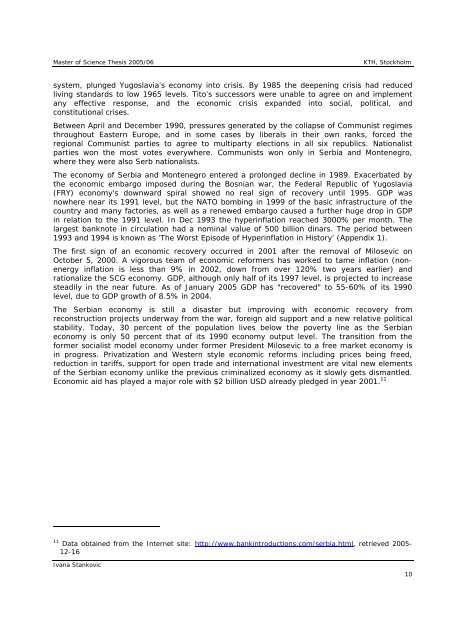Ivana Stankovic
Ivana Stankovic
Ivana Stankovic
You also want an ePaper? Increase the reach of your titles
YUMPU automatically turns print PDFs into web optimized ePapers that Google loves.
Master of Science Thesis 2005/06<br />
KTH, Stockholm<br />
system, plunged Yugoslavia’s economy into crisis. By 1985 the deepening crisis had reduced<br />
living standards to low 1965 levels. Tito’s successors were unable to agree on and implement<br />
any effective response, and the economic crisis expanded into social, political, and<br />
constitutional crises.<br />
Between April and December 1990, pressures generated by the collapse of Communist regimes<br />
throughout Eastern Europe, and in some cases by liberals in their own ranks, forced the<br />
regional Communist parties to agree to multiparty elections in all six republics. Nationalist<br />
parties won the most votes everywhere. Communists won only in Serbia and Montenegro,<br />
where they were also Serb nationalists.<br />
The economy of Serbia and Montenegro entered a prolonged decline in 1989. Exacerbated by<br />
the economic embargo imposed during the Bosnian war, the Federal Republic of Yugoslavia<br />
(FRY) economy's downward spiral showed no real sign of recovery until 1995. GDP was<br />
nowhere near its 1991 level, but the NATO bombing in 1999 of the basic infrastructure of the<br />
country and many factories, as well as a renewed embargo caused a further huge drop in GDP<br />
in relation to the 1991 level. In Dec 1993 the hyperinflation reached 3000% per month. The<br />
largest banknote in circulation had a nominal value of 500 billion dinars. The period between<br />
1993 and 1994 is known as ‘The Worst Episode of Hyperinflation in History’ (Appendix 1).<br />
The first sign of an economic recovery occurred in 2001 after the removal of Milosevic on<br />
October 5, 2000. A vigorous team of economic reformers has worked to tame inflation (nonenergy<br />
inflation is less than 9% in 2002, down from over 120% two years earlier) and<br />
rationalize the SCG economy. GDP, although only half of its 1997 level, is projected to increase<br />
steadily in the near future. As of January 2005 GDP has "recovered" to 55-60% of its 1990<br />
level, due to GDP growth of 8.5% in 2004.<br />
The Serbian economy is still a disaster but improving with economic recovery from<br />
reconstruction projects underway from the war, foreign aid support and a new relative political<br />
stability. Today, 30 percent of the population lives below the poverty line as the Serbian<br />
economy is only 50 percent that of its 1990 economy output level. The transition from the<br />
former socialist model economy under former President Milosevic to a free market economy is<br />
in progress. Privatization and Western style economic reforms including prices being freed,<br />
reduction in tariffs, support for open trade and international investment are vital new elements<br />
of the Serbian economy unlike the previous criminalized economy as it slowly gets dismantled.<br />
Economic aid has played a major role with $2 billion USD already pledged in year 2001. 11<br />
11 Data obtained from the Internet site: http://www.bankintroductions.com/serbia.html, retrieved 2005-<br />
12-16<br />
<strong>Ivana</strong> <strong>Stankovic</strong><br />
10
















